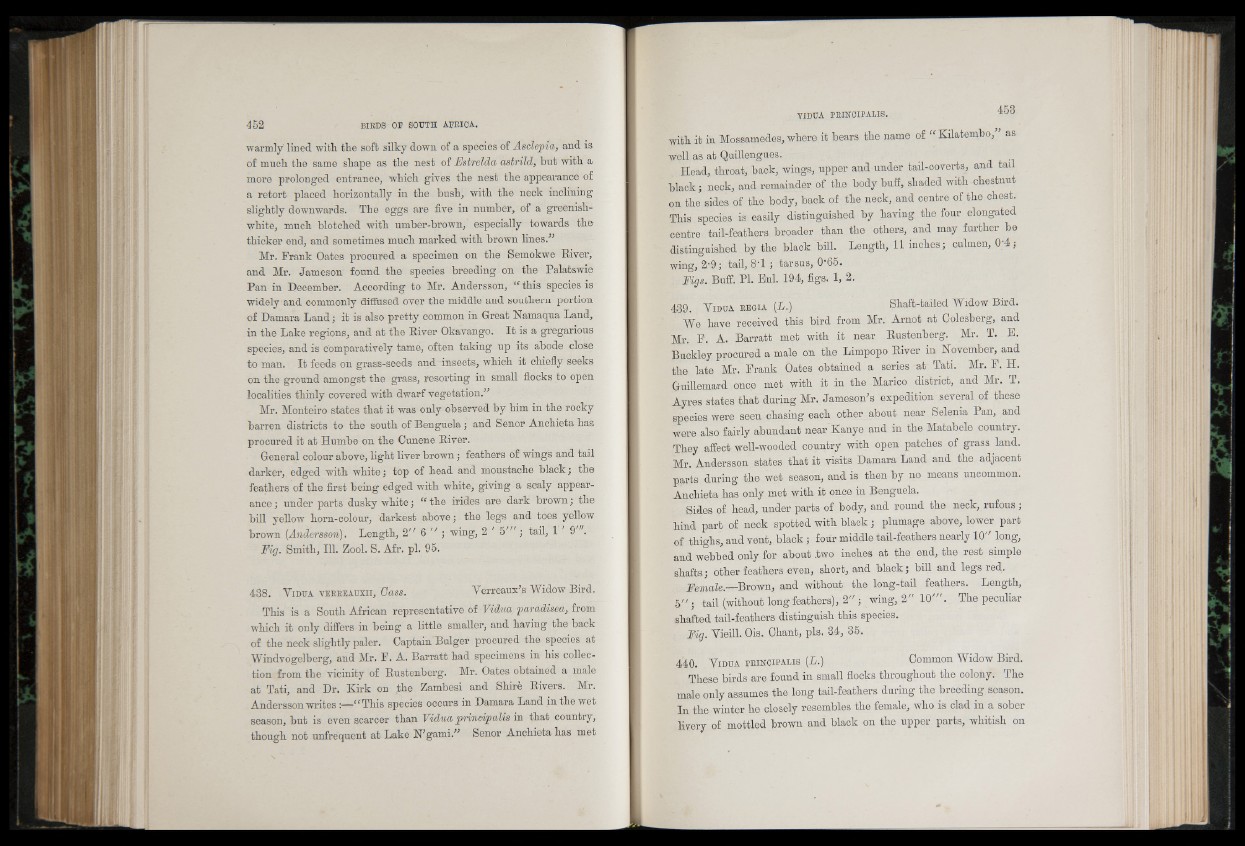
warmly lined with the soft silky down of a species of Asclepia, and is
of much the same shape as the nest of Estrelda astrild, hut with a
more prolonged entrance, which gives the nest the appearance of
a retort placed horizontally in the bush, with the neck inclining
slightly downwards. The eggs are five in number, of a greenish-
white, much blotched with umber-brown, especially towards the
thicker end, and sometimes much marked with brown lines.”
Mr. Frank Oates procured a specimen on the Semokwe River,
and Mr. Jameson found the species breeding on the Palatswie
Pan in December. According to Mr. Andersson, “ this species is
widely and commonly diffused over the middle and southern portion
of Damara Land; it is also pretty common in Great Namaqua Land,
in the Lake regions, and at the River Okavango. I t is a gregarious
species, and is comparatively tame, often taking up its abode close
to man. It feeds on grass-seeds and insects, which it chiefly seeks
on the ground amongst the grass, resorting in small flocks to open
localities thinly covered with dwarf vegetation.”
Mr. Monteiro states that it was only observed by him in the rocky
barren districts to the south of Benguela; and Senor Anchieta has
procured it at Humbe on the Cunene River.
General colour above, light liver brown; feathers of wings and tail
darker, edged with white; top of head and moustache black; the
feathers of the first being edged with white, giving a scaly appearance
; under parts dusky white; “ the irides are dark brown; the
bill yellow horn-colour, darkest above; the legs and toes yellow
brown (Andersson). Length, 2'' 6 " ; wing, 2 5// ; tail, 1 9 .
Fig. Smith, 111. Zool. S. Afr. pi. 95.
438. V id u a v e r r e a u x i i , Gass. Verreaux’s Widow Bird.
This is a South African representative oiVidua paraxlisea, from
which it only differs in being a little smaller, and having the back
of the neck slightly paler. Captain Bulger procured the species at
Windvogelberg, and Mr. F. A. Barratt had specimens in his collection
from the vicinity of Rustenberg. Mr. Oates obtained a male
at Tati, and Dr. Kirk on ¿he Zambesi and Shirk Rivers. Mr.
Andersson writes:—u Tlris species occurs in Damara Land in the wet
season, but is even scarcer than Vidua principalis in that country,
though not unfrequent at Lake N’gami.” Senor Anchieta has met
with it in Mossamedes, where it bears the name of “ Kilatembo,” as
well as at Quillengues.
Head, throat, back, wings, upper and under tail-coverts, and tail
black; neck, and remainder of the body buff, shaded with chestnut
on the sides of the body, back of the neck, and centre of the chest.
This species is easily distinguished by having the four elongated
centre tail-feathers broader than the others, and may further be
distinguished by the black bill. Length, 11 inches; culmen, 0 4;
•wing, 2*9 j tail, 8*1 j tarsus, 0 65.
Figs. Buff. PL Enl. 194, figs. 1, 2.
439. V id u a r e g ia (L.) Shaft-tailed Widow Bird.
We have received this bird from Mr. Arnot at Golesberg, and
Mr. F. A. Barratt met with it near Rustenberg. Mr. T. E.
Buckley procured a male on the Limpopo River m November, and
the late Mr. Frank Oates obtained a series at Tati. Mr. F. H.
Guillemard once met with it in the Marico district, and Mr. T.
Ayres states that during Mr. Jameson’s expedition several of these
species were seen chasing each other about near Selenia Pan, and
were also fairly abundant near Kanye and in the Matabele country.
They affect well-wooded country with open patches of grass land.
Mr. Andersson states that it visits Damara Land and the adjacent
parts during the wet season, and is then by no means uncommon.
Anchieta has only met with it once in Benguela.
Sides of head, under parts of body, and round the neck, rufous;
hind part of neck spotted with black ; plumage above, lower part
of thighs, and vent, black; four middle tail-feathers nearly 10” long,
and webbed only for about two inches at the end, the rest simple
shafts; other feathers even, short, and black; bill and legs red.
Female.—Brown, and without the long-tail feathers. Length,
5 " ; tail (without long feathers), 2” ; wing, 2” 10'” . The peculiar
shafted tail-feathers distinguish this species.
Fig. Vieill. Ois. Chant, pis. 34, 35.
440. V id u a p r in c ip a l is (L.) Common Widow Bird.
These birds are found in small flocks throughout the colony. The
male only assumes the long tail-feathers during the breeding season.
In the winter he closely resembles the female, who is clad in a sober
livery of mottled brown and black on the upper parts, whitish on